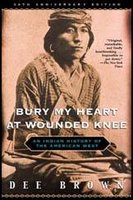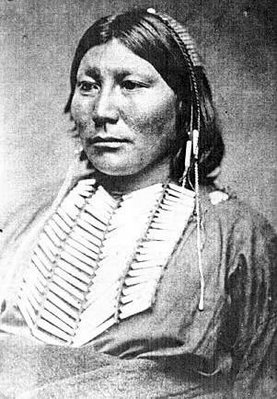A few days ago when I was reflecting upon and researching Boxing Day, I came to the realization that we do seem to overlook historical events that take place on or near major holidays. For example, even though it was a very recent event, I had not remembered that the 2004 catastrophic tsunami had occurred on the day after Christmas, Boxing Day. I somehow knew it had occurred in late December, but had I not been researching Boxing Day I never would have made the connection between the two.
Likewise, I would not have remembered the today is the 126th anniversary of the massacre (no, I do not believe that is a politically incorrect term) at
In February of 1973 Native People elders of the Pine Ridge Reservation and members of the American Indian Movement (AIM)—several hundred men and women, young people and elders—went to Wounded Knee, site of the 1890 massacre, and “occupied it.” They were soon surrounded by the state police, FBI agents, BIF agents, etc. The occupation and siege created headlines around the world.
At about the same time, I, as a very new and inexperienced social worker had referred to me a new client, Tonya Whitehorse. Of all of the clients with whom I have worked, I believe that Tonya was the most unique. He claimed to be (about) 80 years old, thin with skin gnarled like the trunk of an old tree. The day I met him he was sitting outside of his bungalow in the
I was more fascinated by the stories he old me—stories of his life, Native  American legends, his view of the world, etc. Not long before I met Tonya, I had read Dee Brown’s incredible book, Bury My Heart at Wounded Knee
American legends, his view of the world, etc. Not long before I met Tonya, I had read Dee Brown’s incredible book, Bury My Heart at Wounded Knee. It is a manuscript that goes far beyond the 1890 massacre; it chronicles primarily the relations and conflicts between Native Peoples and the westward moving people of European origin over the thirty-year period from 1860 to 1890. It was “the first account of the time period told from the Native-American point of view.” (See eNotes: Bury My Heart at Wounded Knee/Introduction).
Brown’s book had opened my eyes to events in a way that no history I had read before had. So it was natural that I should bring it up with Tonya. He told me he had read it—borrowed it from the public library—and asked me to bring my copy the next time I came to his home. Of course, I returned with the book much sooner than, as a social worker, I needed to visit him. I sat beside Tonya holding the book in my hands as he carved another walking stick . Tonya, without looking up, told me to turn to a specific page in the picture section in the middle of the book. He pointed to a picture of a Kiowa chief named White Horse and said, “He was my father. I was conceived the year he died.”
Kiowa Chief, White Horse (Tsen-tainte)
I must admit that I took almost everything Tonya told me with a very large grain of salt. However, I would like to believe that his stories—growing up on an Oklahoma reservation; earning university degrees in engineering and law; serving in World War II; meeting personally every U. S. President from Woodrow Wilson to Lyndon Johnson—were true.
Back to today’s anniversary of the
I then asked Tonya about the current (1973) AIM occupation of
On this 116th anniversary of the massacre at
I end with the reflection of Black Elk regarding the
I did not know then how much was ended. When I look back now from this high hill of my old age, I can still see the butchered women and children lying heaped and scattered all along the crooked gulch as plain as when I saw them with eyes still young. And I can see that something else died there in the bloody mud, and was buried in the blizzard. A people's dream died there. It was a beautiful dream. . . the nation's hoop is broken and scattered. There is no center any longer, and the sacred tree is dead.
The
Lakota Accounts of the Massacre at
A Tattoo on My Heart: The Warriors of
(Lyrics) Wounded Knee/Big Foot by Johnny Cash (1972)

Nick thank you for remembering the anniversary of Wounded Knee. Many Americans do not know this history or care about it for that matter. It is so telling of our governments and our behavior to one another. It is a shame that we do not seem to learn from it. Perhaps that is the destiny of human nature.
ReplyDeleteWounded Knee, both 1890 and 1973, were events that weigh on the consciences of all of us European Americans. Thank you for the blog and the links. By following them, I have learned more than I thought I would.
ReplyDeleteI hope you write more about Mr. Whitehorse. He seems like a really interesting character, even with a big grain of salt.
Hi Nick ~~ Very interesting post about the Massacre at Wounded Knee.
ReplyDeleteThank you for your welcome back and the comment that Christmas need never be over if we have the Spirit in our hearts. Glad you had a nice Christmas with family and I wish you a happy, healthy and prosperous New Year in 2007.Take care Nick, Regards, Merle.
I came to say happy after the holidays to you and your fuzzy owner
ReplyDeleteMy birthday sometimes coincides with Father's Day. It's not hugely bad for me.
ReplyDelete-N
i not heard of wounded knee wow
ReplyDeleteHAPPY NEW YEAR in case I don't get back before next year. :)
ReplyDeleteExcellent post, Saint. We’ve discussed Wounded Knee (both massacre and occupation), but I don’t remember the story of White Horse. Please write more.
ReplyDeleteBy the way, here’s another link for you: http://www.woundedkneemuseum.org/main_menu.html
Was aware but had not read about it -
ReplyDeleteWhat an interesting man - his carved works sound beautiful! Not something you see too often...
Know someone who taught on a reservation - it took a while but the people learned to trust her, & many of her students are moving on to college - but from what I understand there's still a need for good teachers.
Geez Saint Nick - your b'day's on St. Valentine's day? How appropriate:)
Nick, what can I say but thank you, again, for remembering those who are so often forgotten
ReplyDeletexx
Very interesting story about Tonya, Nick. I would love to hear more about him.
ReplyDelete